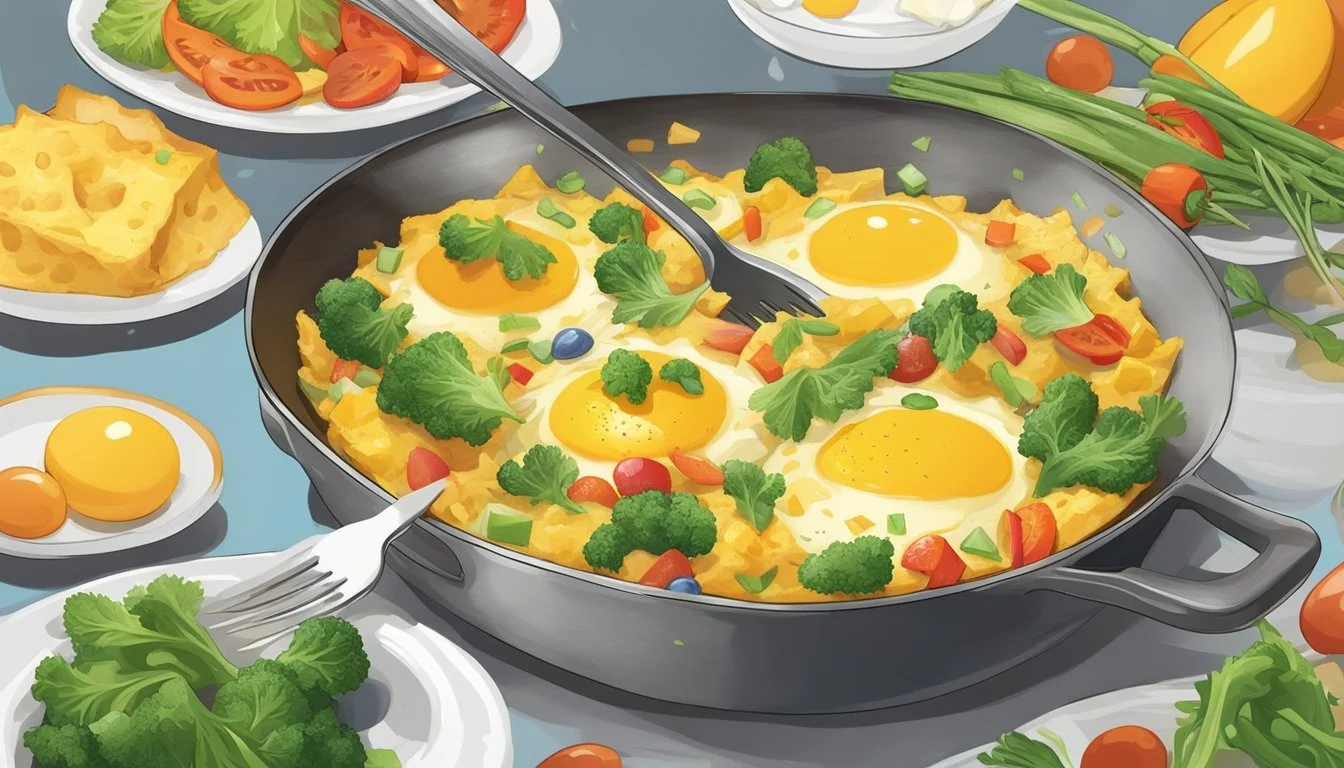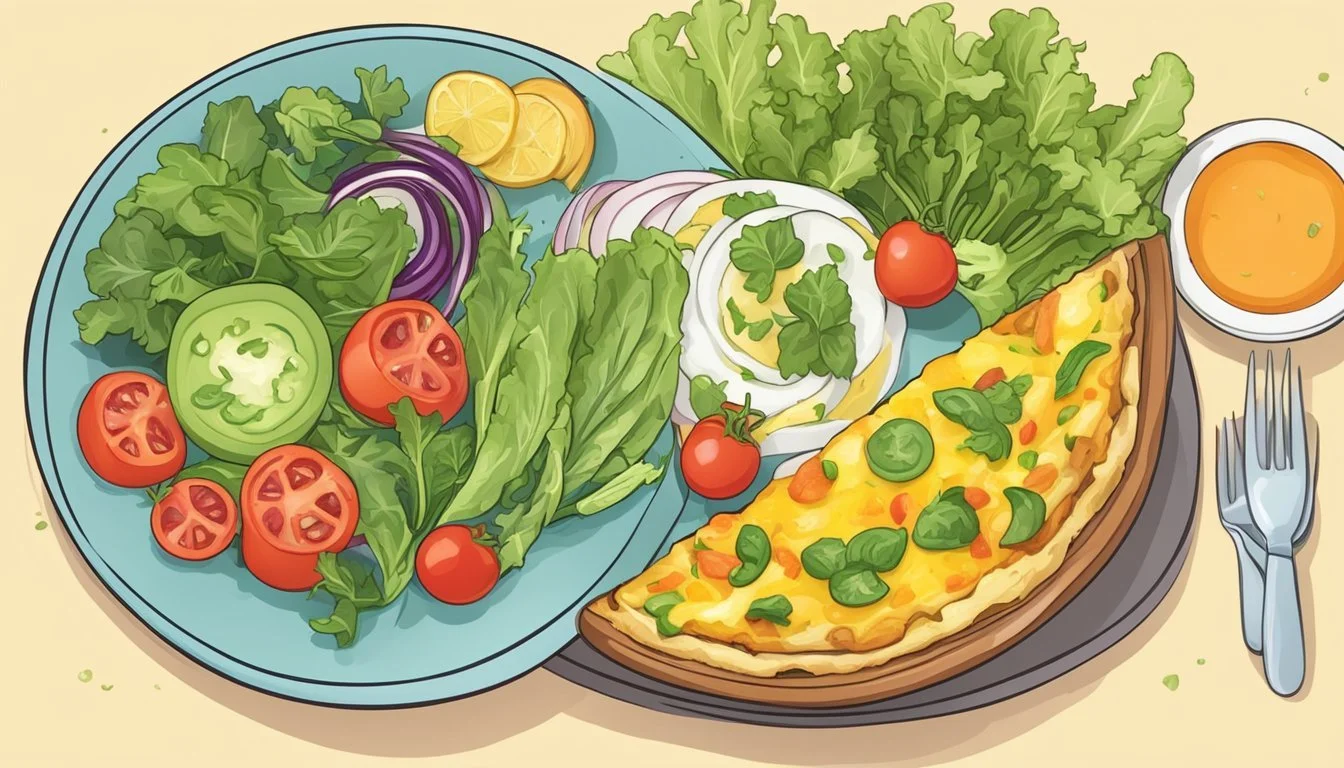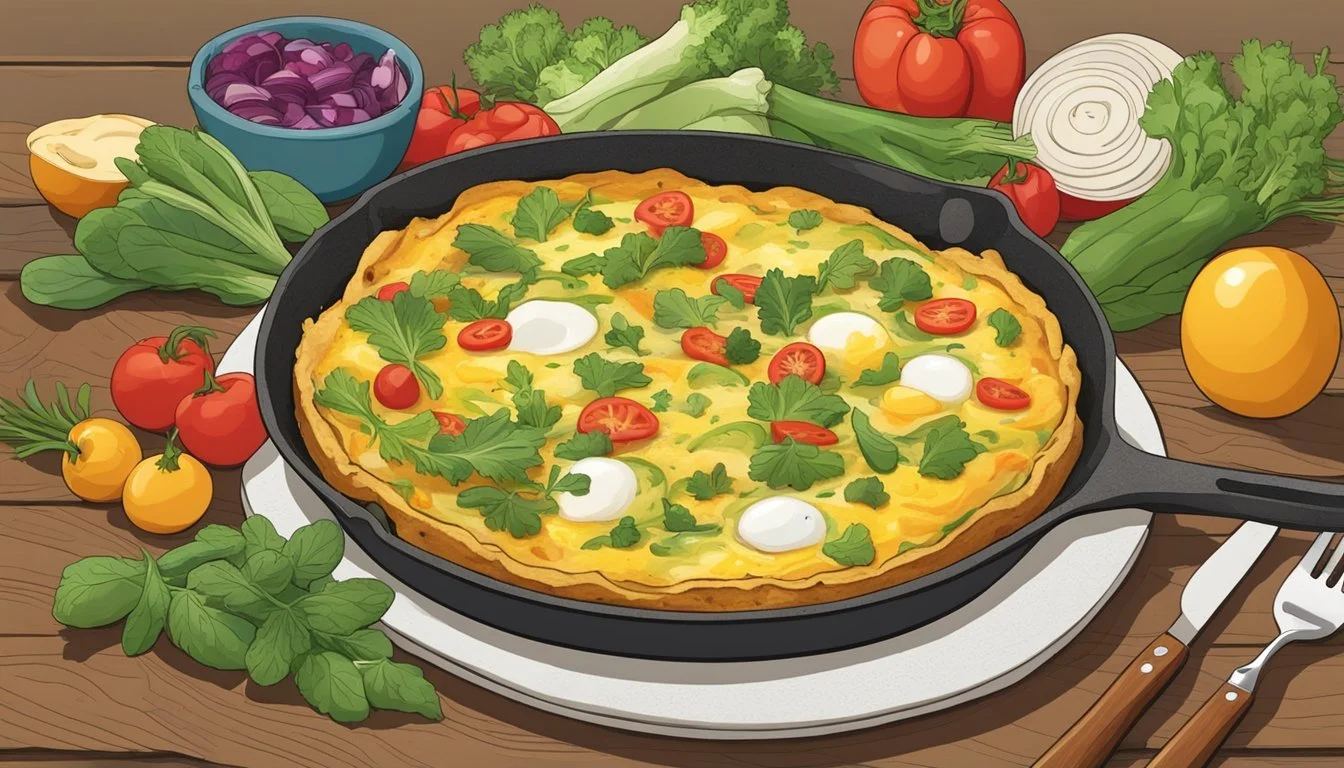How do you eat a frittata?
Tips for Enjoying This Versatile Dish
A frittata is a versatile and egg-based dish that's as suitable for breakfast as it is for lunch (What wine goes well with lunch?) or dinner. Originating from Italy, it can be described as a cross between an omelette and a quiche, (What wine goes well with quiche?) minus the crust. What sets the frittata apart is its method of cooking – starting on the stove and typically finished in the oven to achieve a fluffy texture and a beautifully browned top. This culinary delight can be filled with a variety of ingredients, from vegetables and cheeses to meats and herbs, making it a canvas for creativity and a champion of leftovers.
Eating a frittata can be as casual or formal as the occasion calls for. For breakfast or brunch, it can be served in wedges, allowing the diner to appreciate the layers and colors of the added ingredients. Lunch might see the frittata packed as a portable slice, ideal for an on-the-go meal or a sophisticated addition to a picnic basket. During dinner, a frittata can take center stage or act as a complement to a more complex meal, offering a rich and satisfying option that is both nutritious and pleasing to the palate.
The beauty of a frittata lies not just in its simplicity and ease of preparation, but also in the way it's eaten. There is no single correct manner to enjoy a frittata; whether it's served hot straight from the oven, at room temperature, or even cold from the refrigerator, it maintains its appeal. Cut into wedges, squares, or even bite-sized cubes for hors d'oeuvres, the frittata is a testament to the adaptability and timeless charm of egg dishes in cuisines worldwide.
Frittata Basics
Frittata, the versatile Italian egg-based dish, can serve as a simple yet elegant meal at any time of day. With just a handful of ingredients and the appropriate kitchen tools, anyone can create this delightful dish.
Understanding Frittatas
A frittata is essentially an Italian open-faced omelette, thickened with ingredients like cheeses, vegetables, meats, or herbs. The key to a frittata's unique texture is the cooking technique—they begin on the stovetop and are typically finished in the oven, resulting in a custardy center and a slightly golden top.
Essential Ingredients
Eggs: The foundation of any frittata, providing structure and richness.
Dairy: Choices such as whole milk, cheese, or cream contribute to the frittata's creaminess.
Fillings: This can range from vegetables and meats to herbs and cheeses. The combination of fillings is vast, but they should all complement each other.
Equipments Needed
Skillet: A non-stick or well-seasoned cast-iron skillet, ideally oven-proof, is essential.
Oven: Preheating an oven is a crucial step, as the frittata needs to be transferred from stovetop to oven to finish cooking.
Preparation Techniques
In creating the ideal frittata, precision in preparation techniques is crucial. The way one handles eggs and combines ingredients can make a remarkable difference in texture and flavor.
Whisking Eggs
One begins by cracking the eggs into a medium bowl. It's essential to whisk them just enough to blend the yolks and whites—this usually means stopping when the mixture is uniform in color. Using a whisk or a fork, one should avoid overbeating as this incorporates too much air, potentially leading to a dry and spongy texture. The goal is a slightly frothy but not overly aerated mixture.
Combining Ingredients
After the eggs are prepared, it’s time to add dairy. Choices such as milk, heavy cream, or yogurt contribute to the creamy texture of the frittata. A good rule of thumb is to add dairy in a 1:8 ratio—that's one part dairy to eight parts egg.
Salt and black pepper are fundamental for flavoring; typically, a pinch of salt and a grind of black pepper per egg is sufficient.
The next step is blending these ingredients smoothly with the eggs.
Finally, one combines the egg-dairy mixture with other precooked fillings, if desired, before proceeding to cook the frittata.
Cooking Methods
The frittata offers flexibility, allowing chefs to start on the stove and finish in the oven. Mastery of both methods yields a deliciously fluffy and versatile dish.
Stovetop Cooking
A chef should begin by heating an oven-safe skillet, preferably cast iron, on the stovetop over medium heat. They need to sauté their chosen fillings in the skillet before the egg mixture is added. A cast iron skillet is ideal due to its even heat distribution and the ability to retain heat when the frittata is transferred to the oven for finishing.
Oven Finishing
Once the eggs are slightly set on the stovetop, the skillet is then moved to a preheated oven. Typically, the oven is set at a moderate temperature—around 350 degrees Fahrenheit. Timing is key; the frittata is baked until just set, usually taking between 8 to 14 minutes. Some chefs might employ a broiler for the final few minutes to achieve a golden top. An oven-safe skillet is crucial here, as it transitions from stovetop to oven seamlessly.
Vegetable Integration
Integrating vegetables into a frittata not only adds nutrition but also enhances the flavor and texture. Proper preparation and cooking techniques ensure that the vegetables contribute to a delicious and well-balanced dish.
Sautéing Veggies
When sautéing vegetables for a frittata, one should begin with those that have longer cooking times. For instance, onions and garlic should be sautéed first to bring out their sweetness and to ensure they are fully cooked. Following onions and garlic, vegetables like zucchini and broccoli (how long does broccoli last?) can be added as they require a moderate amount of time to soften. Spinach, which wilts quickly, should be introduced last. It is essential to cook vegetables until they are just tender to avoid a soggy frittata. The vegetables should be evenly distributed throughout the egg mixture before baking.
Order of Sautéing:
Onions and garlic – until translucent.
Broccoli and zucchini – until they start to soften.
Spinach – until just wilted.
Incorporating Pre-Cooked Vegetables
Pre-cooking certain vegetables can expedite the frittata-making process and ensure each component retains its desired texture. Vegetables like asparagus, tomatoes, and broccoli benefit from being roasted or blanched beforehand to bring out their flavors and to ensure they mix well with the eggs. One must cool the pre-cooked vegetables (how long do cooked vegetables last?) before integrating them into the egg mixture to prevent premature cooking of the eggs. Once cooled, they can be folded into the beaten eggs along with any desired herbs or cheese.
Pre-Cooking Techniques:
Oven roast tomatoes and asparagus to enhance their flavors.
Blanch broccoli to maintain its vibrant color and crunch.
In both cases, evenly incorporating the vegetables into the egg mixture allows for a uniform distribution of flavor and ensures that every bite contains a taste of the included vegetables.
Including Proteins and Cheeses
A well-prepared frittata includes an assortment of cheeses and proteins, ensuring a rich flavor and satisfying texture. The selection of these ingredients should be thoughtful, balancing taste and meltability for cheeses, and considering the variety and preparation of meats.
Selecting Cheeses
When choosing cheeses for a frittata, one should consider how well they melt and their flavor profile. Cheddar cheese offers a sharp, pronounced taste and excellent meltability, which can enhance the overall savory experience. Parmesan brings a salty and nutty essence and is ideal for creating a golden top crust. Feta cheese adds a tangy edge, and since it does not melt as readily, it creates pockets of distinct flavor. Other suitable choices include mozzarella for its mild taste and stretchy texture, and goat cheese, which offers a creamy and tart note to the dish.
Adding Meats
Including meats in a frittata introduces not just protein, but also an additional layer of flavor and texture. Bacon (how long does bacon last?) is a popular choice, providing a smoky taste and a crisp contrast to the softness of the egg. It should be cooked until crisp before incorporating into the frittata. Turkey bacon is a leaner alternative with a similar flavor spectrum. Ham can be diced and added for a salty bite that pairs well with a multitude of cheeses. It's important to cook and crumble or chop meats into bite-size pieces before adding to ensure even distribution and thorough cooking within the frittata.
Perfecting the Texture
To attain the perfect frittata texture, one must aim for a custardy center, evading the common mishaps that lead to a less desirable consistency.
Achieving Custardy Consistency
A custardy frittata is characterized by its tender, lightly set consistency. To achieve this:
Gentle Whisking: Eggs should be whisked just enough to blend yolks and whites, which prevents the introduction of excess air and maintains a rich, custardy texture.
Moderate Heat: Cooking the frittata over moderate heat allows the eggs to set slowly, ensuring they remain moist and do not become rubbery.
Avoiding Common Pitfalls
Several common errors can lead to a frittata's texture being compromised:
Overbeating the Eggs: Vigorous whisking incorporates too much air and can yield a spongy, rubbery texture.
High Heat: Cooking at too high of a temperature can expel moisture quickly, leading to dryness.
Prolonged Cooking: Overcooking a frittata squeezes out moisture, pushing beyond light and fluffy to toughened and chewy.
Serving Suggestions
When enjoying a frittata, complementing it with the right side dishes and garnishes can elevate the meal. These serving suggestions focus on enhancing the flavors and textures that pair well with the versatility of a frittata.
Dish Pairings
Frittatas pair wonderfully with a variety of sides:
Salads: A fresh, tossed green salad provides a crisp contrast to the richness of the eggs.
Potatoes: Hash browns or garlicky roasted red potatoes offer a satisfying carbohydrate component.
Beans: For a heartier accompaniment, baked beans or a tomato and feta white bean salad add both protein and fiber.
One can also consider a blend of fried potatoes with bacon, or for a lighter option, kale crisps, to balance the meal.
Appropriate Garnishes
Enhancing a frittata with the right toppings brings out its flavor:
Fresh herbs: Sprinkle with chopped parsley, chives (how long do chives last?) or cilantro for a fresh burst of flavor.
Salsas: A dollop of Pico de Gallo or a spoonful of salsa adds spice and zest.
Avocado: Slices of avocado or guacamole lend a creamy texture and rich taste.
Pesto: A swirl of pesto can introduce a robust herby dimension to the dish.
These additions not only add a pop of color but also complement the flavor profile of the frittata.
Advanced Frittata Concepts
Exploring advanced frittata concepts involves integrating unexpected ingredient pairings and considering dietary variations that maintain the dish's integrity. These sophisticated approaches bring depth and versatility to the frittata.
Creative Flavor Combinations
Creative flavor combinations elevate the traditional Italian frittata. Chefs often incorporate a blend of fresh herbs, like basil and dill (how long does dill last?), to add layers of flavor. For a bold twist, one might integrate arugula (how long does arugula last?) for its peppery notes. Matching these greens with robust cheeses and vibrant vegetables can transform the dish. Here are a few specific pairings:
Italian Classic: Tomato, basil, and mozzarella
Herb Delight: Dill, chives, and goat cheese
Peppery Twist: Arugula, parmesan, and sun-dried tomatoes
These combinations are not only about taste but also about creating a visually appealing dish with a balance of colors and textures.
Frittata Variations for Dietary Restrictions
For a vegetarian option, a frittata can be loaded with various vegetables or even leftover roasted dishes from the night before. Utilizing leftover vegetables not only adds flavor but also reduces food waste. As for dairy, alternatives like sour cream or crème fraîche can offer a tangy richness and can be substituted with non-dairy versions if needed.
Particular attention is given to ensuring that these substitutes compliment the frittata's flavor profile:
Dietary Restriction Ingredient Replacement Dairy-Free Plant-based creams or cheeses Gluten-Free Ensure no gluten-containing additives Vegetarian Focus on cheeses, vegetables, and herbs
A frittata’s versatility allows it to be tailored to specific dietary needs without compromising on flavor or texture, making it an inclusive dish for all preferences.
Post-Cooking Tips
Once the frittata is cooked, proper storage and reheating methods ensure the dish retains its texture and flavor. These tips are particularly helpful for those who have leftovers or prefer to meal prep.
Ideal Storage Methods
To store a frittata, one should allow it to cool to room temperature after cooking. Using an airtight container is essential to prevent moisture loss and odors from affecting the quality of the frittata. If cooked in a cast-iron skillet, transfer the frittata to a storage container as prolonged exposure to the pan may affect its flavor. In case of refrigeration, a frittata can be kept for up to 4 days.
Reheating Leftovers
When reheating frittata leftovers, one can use either an oven or a microwave. For best results, heat the oven to 350 degrees Fahrenheit and place the frittata inside for about 10 to 15 minutes or until it is thoroughly warmed. A nonstick pan on the stovetop over medium heat also works, flipping it gently with a spatula to ensure even warming. Those using a microwave should heat slices for 20-30 seconds at a time to avoid rubbery eggs. If the frittata contains hash browns or other ingredients that benefit from crisping, an oven or stovetop method is preferable.
Concluding Thoughts
Eating a frittata epitomizes simplicity and versatility in a dish that can be enjoyed for any meal. A frittata's variety and ease make it an excellent choice for both novice cooks and seasoned chefs. Its basic formula—eggs combined with a selection of vegetables, meats, and cheeses—allows for creativity as well as the use of leftovers.
When consuming a frittata, one should appreciate its straightforward yet satisfying nature. Whether served hot or cold, it fits seamlessly into a meal plan. For those leading a busy lifestyle, a frittata is easy to eat on the go. It can be cut into slices, making it a convenient option for picnics or packed lunches.
The dish's adaptability is also noteworthy. It can be a hearty breakfast, a light lunch, or the centerpiece of a dinner. A frittata can accommodate various dietary preferences and restrictions. By selecting appropriate ingredients, it remains an inclusive food choice.
Moreover, a frittata maintains its quality as it rests. The flavors often meld and mature, providing a different experience when eaten after it has cooled down.
In short, the frittata carries with it an assurance of a satisfying meal. Its ease and versatility are hallmarks that have earned it a beloved place in kitchens worldwide. Whether one is aiming for a quick meal fix or an impressive brunch option, the frittata stands ready as a testament to culinary practicality.









